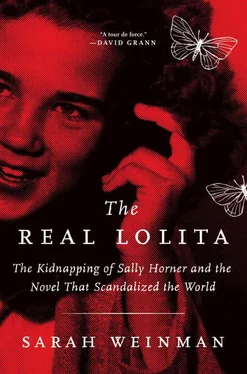“DID YOU SAY THAT SALLY HORNER was the inspiration for Lolita ?” Carol Starts said at the beginning of our first conversation in December 2016, once I’d explained why I was calling her out of the blue. Her incredulity was palpable. So, too, was her admiration for her long-deceased best friend.
“I was so unbelievably impressed by her. Sally taught me a great deal. After she was gone, I went through modeling classes to be a ‘lady.’ Because that’s the way Sally was. I wanted to be like her. So I was. I went through those classes, how to walk and sit and stand and so forth. I paid attention to actions, movements, how to dress, and thoroughly enjoyed it because I could be just like Sally. I was on the wrong side of the tracks. I didn’t have much mentorship prior to her.”
The strong impression Sally made endured for Carol’s entire life. She left Camden for California at eighteen to marry her first husband. She kept his last name of Taylor—she was glad to shed her maiden name, which had caused her no end of teasing at school—married and divorced three more times, and had four children. Carol died on October 30, 2017, in Melbourne, Florida, where she lived with one of her daughters. She was eighty years old.
EDWARD BAKER GOT ON with his life after the accident that killed Sally. He was drafted into the army in the summer of 1954 and spent more than eight months at Schweinfurt, Germany, where he celebrated his twenty-third birthday. Upon returning to Vineland, he married, had a son he named Edward Jr., and worked as a machinist, with side interests in riding and fixing motorcycles and watching NASCAR. Both father and son volunteered substantial amounts of time with the local YMCA. But several years before Edward Baker’s death in 2014, fate had another twist in store for him.
On the afternoon of Wednesday, May 17, 2007, his son fell asleep in his Mercury Grand Marquis. The car crossed the middle lane and into the median, then careened along the shoulder of Route 55, slamming into a tree. Just as Sally Horner had, fifty-five years earlier, Edward Baker, Jr., died instantly.
THE TWO CAMDEN POLICE DETECTIVES involved with Sally Horner’s rescue, Marshall Thompson and Wilfred Dube, both retired in the mid-1960s. Dube had risen to become chief of detectives; Thompson remained a detective until his sixtieth birthday. Dube died in 1980; Thompson in 1982. Howard Hornbuckle served one more term as Santa Clara County sheriff, and retired to work as a dairy farm sales representative. He died in 1962.
MITCHELL COHEN’S HEALTH suffered after the Sally Horner case concluded. Her rescue, and Frank La Salle’s imprisonment, took place only a few months after Howard Unruh’s massacre, an exhausting one-two combination for the Camden County prosecutor. Cohen spent three days in the hospital at the end of August 1950. Doctors ordered him to take a rest from his work; he took their advice and left Camden for a week in the White Mountains of New Hampshire.
Upon his return, and over the next eight years, there were more major crimes for Cohen to prosecute, including the ones resulting in the 1955 execution of three men for murdering a luncheonette owner during a botched robbery. Then came his next career move, when the new New Jersey governor at the time, Robert B. Meyner, appointed Cohen as Camden County Court judge. In doing so the governor displaced Rocco Palese, the judge who had sentenced Frank La Salle to prison. Controversy ensued in the form of a letter-writing campaign and newspaper editorials, but Palese eventually acquiesced and moved into private practice. (He died in 1987 at the age of ninety-three.)
Cohen served three years on the county court bench before moving over to the appeals court for a year. He was then appointed a federal court judge by President Kennedy in 1962, and he stayed on the bench for the rest of his life. Cohen died in 1991, at eighty-six.
AS LOLITA BEGAN its climb up the bestseller charts, Véra Nabokov continued what had become a custom for her since May 20, 1958: jotting down her private thoughts in the diary that had previously been the sole property of her husband. Véra’s notes largely indicate delight at Lolita ’s success, but one subject bothered her above all: the way that public reception, and critical assessments, seemed to forget that there was a little girl at the center of the novel, and that she deserved more attention and care:
I wish someone would notice the tender description of the child’s helplessness, her pathetic dependence upon the monstrous HH, and her heartrending courage all along, culminating in that squalid but essentially pure and healthy marriage, and her letter, and her dog. And that terrible expression on her face when she had been cheated by HH out of some little pleasure that had been promised. They all miss the fact that the “horrid little brat” Lolita is essentially very good indeed—or she would not have straightened out after being crushed so terribly, and found a decent life with poor Dick more to her liking than the other kind.
Vera, of course, did not intend her thoughts for publication, and Vladimir Nabokov did not express these thoughts in public, either. Lolita ’s success almost seemed designed so people missed the point. Its original publication by Olympia Press established its bona fides as a book too controversial for American consumption. And then, once it was finally published in the United States, the conversation centered around Humbert Humbert’s desires and his “love story” with Dolores Haze, with few acknowledging, or even comprehending, that their relationship was an abuse of power.
As a result, that left a vacuum for decades of readers to misinterpret Lolita . It allowed for a culture of teen-temptress vamping that did not account for the victimization at the novel’s core. Sixty years on, many readers still don’t see through Humbert Humbert’s vile perversions, and still blame Dolores Haze for her behavior, as if she had the will to resist, and chose not to.
LATER IN THE YEAR, Véra wrote in her diary about a strange evening that foreshadowed all the ways in which Lolita would be viewed as grim comedy instead of the moral indictment she’d hoped for. On November 26, 1958, Vladimir and Véra Nabokov went out to dinner at Cafe Chambord on Third Avenue and Forty-Ninth Street. The other dinner guests included Walter Minton and his wife, Polly, as well as Victor Schaller, Putnam’s head of finance, and his wife. The mood should have been celebratory in light of Lolita ’s increasing success. It was not, as Véra later wrote in great detail, because the Mintons were unduly preoccupied with a Time magazine article published the previous week.
The article, unbylined but written by staff writer and future Los Angeles Times gossip columnist Joyce Haber, was ostensibly about the public reception of Lolita . Haber opened with an account of Nabokov at a Putnam-sponsored reception for the novel, where he, according to Haber, “faced a formidable force of 1,000 literature-loving women.” After quickly dispensing with the positive and negative critical reception for Lolita, Haber let loose on Rosemary Ridgewell, the showgirl-turned-literary-scout, with carefully calibrated bile.
Haber described Ridgewell as “a superannuated (27) nymphet… a tall (5 ft. 8 in.) slithery-blithery onetime Latin Quarter showgirl who wears a gold swizzle stick around her neck and a bubbly smile on her face. Well may she bubble.” Ridgewell merited Haber’s attention for tipping off Minton to Lolita ’s existence after reading excerpts in the Anchor Review . But the cause of Haber’s ire was that she and Ridgewell were Walter Minton’s mistresses at the same time. No wonder she felt compelled to douse her rival in the prose equivalent of hydrochloric acid.
Читать дальше












